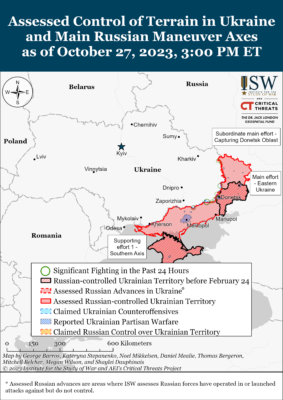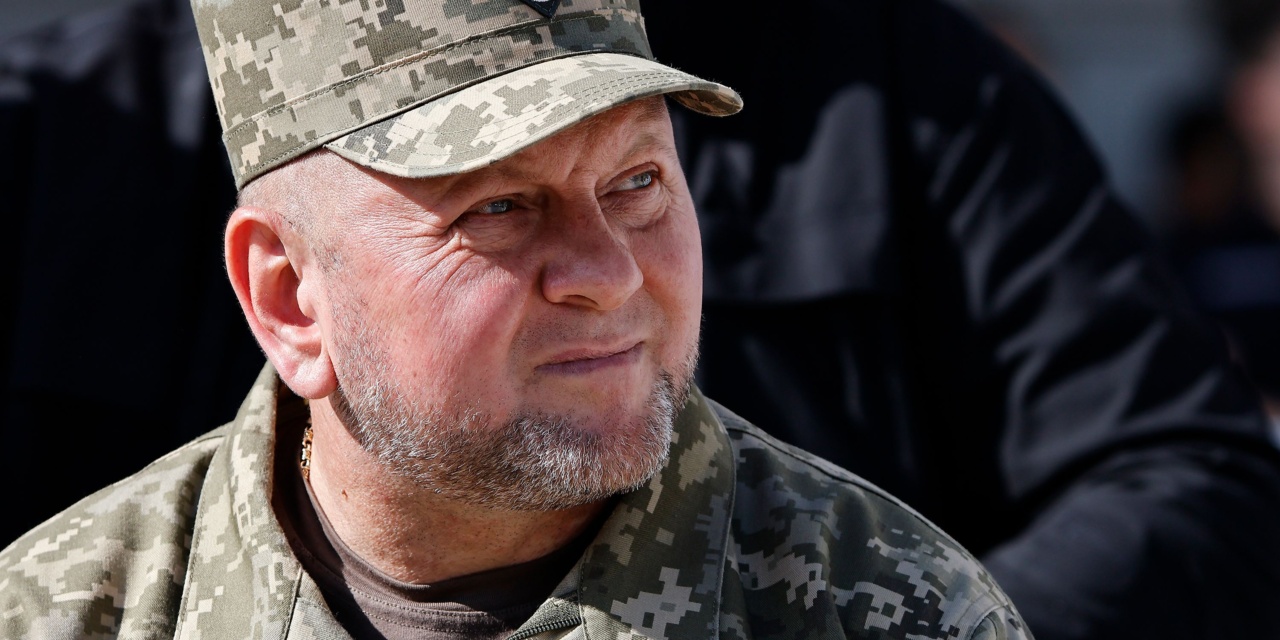Commander of Ukraine’s armed forces, Valery Zaluzhnyi, at an event for Independence Day, August 24, 2023, Kyiv (Yan Dobronosov/Global Images Ukraine/Getty)
Wednesday’s Coverage: 18 of 20 Russia’s Iranian Drones Downed, But Oil Refinery Hit in Kremenchuk

Map: Institute for the Study of War
UPDATE 1518 GMT:
An 81-year-old woman and a 60-year-old man have been killed by the latest Russian shelling of the Kherson region in southern Ukraine.
Four other people were wounded by the strikes on residential and public buildings.
UPDATE 1501 GMT:
The US has imposed further sanctions on Russia, covering hundreds of entities and individuals, over energy projects, sanctions evasion, and a suicide drone.
The blacklist targets the development, operation, and ownership of the Siberian project Arctic-2 LNG, which plans to ship liquefied natural gas to global markets.
A network is designated over the KUB-BLA and Lancet suicide drones used by the Russian military in Ukraine. Included are 12 Russian companies such as Hartis DV LLC and Alfakomponent.
Other entities are cited over sanctions evasion in the UAE, Turkey, and China, where companies are sending high priority dual-use products and components for weapons systems to Russia.
Seven Russia-based banks and dozens of industrial firms are named.
UPDATE 1025 GMT:
An assessment by UK military intelligence intersects with the priority of Ukraine’s top commander, Gen. Valery Zalushnyi, on degrading Russia’s air defenses (see Original Entry).
The analysts note that Ukrainian strikes have probably destroyed at least four Russian long range surface-to-air missile launchers in the past week.
Russian media acknowledged last Thursday that three SA-21 launchers had been destroyed in the Luhansk region in eastern Ukraine. Ukrainian sources reported additional Russian losses in occupied Crimea.
UK intelligence concludes that the losses highlight the continued struggle of Russia’s integrated air defence system continues to struggle against modern precision-strike weapons.
They add that if Russia replaces the destroyed systems in Ukraine, it will likely weaken iair defenses in other operational areas.
UPDATE 0612 GMT:
South Korea’s intelligence service NIS says it has confirmed delivery of shells from North Korea to Russia. says South Korean legislator Yoo Sang-bum.
Yoo spoke after a closed-door briefing by NIS. He said Pyongyang had sent a two-month supply of munitions to the Russians since early August.
Russian Defense Minister Sergey Shoygu visited Pyongyang in July. Vladimir Putin hosted North Korean leader Kim Jong-in in eastern Russia in September, and Russian Foreign Minister Sergey Lavrov travelled to Pyongyang last month.
South Korea and its partners are concerned that Russia could provide North Korea with technological support for its nuclear weapons and missiles programme. The NIS said it was more likely that the Russian assistance will be for conventional capabilities, including North Korea’s fighter jets.
ORIGINAL ENTRY: The commander of Ukraine’s armed forces, Gen. Valery Zalushnyi, has warned that the country faces a “static and attritional stalemate” as it tries to defeat Russia 20-month invasion.
Ukraine’s counter-offensive has advanced gradually in both the south and east since early June, but forces are fending off Russian attempts to regain areas near Kupyansk in the Kharkiv region and Avdiivka in the Donetsk region.
Zaluzhnyi told The Economist that his units need new military capabilities and technological innovation to make a decisive breakthrough. He cautioned:
Just like in the First World War we have reached the level of technology that puts us into a stalemate….
This will benefit Russia, allowing it to rebuild its military power, eventually threatening Ukraine’s armed forces and the state itself.
The general cited the need to overcome Russia’s advantage in airpower, with Ukraine conduct intense drone strikes to overload Moscow’s air defenses.
He also explained that Ukraine must build reserve forces despite limitations on training inside the country and gaps in legislation allowing people to evade service.
We are trying to fix these problems. We are introducing a unified register of draftees, and we must expand the category of citizens who can be called up for training or mobilization.
We are also introducing a ‘combat internship’, which involves placing newly mobilized and trained personnel in experienced frontline units to prepare them.
“Both We and Our Enemies Are in a Stupor”
Speaking frankly about the slower-than-desired advance of the five-month counter-offensive, Zalushnyi admitted that he underestimated the Russian willingness to take heavy losses: “That was my mistake. Russia has lost at least 150,000 dead. In any other country such casualties would have stopped the war.”
The general continued:
First I thought there was something wrong with our commanders, so I changed some of them. Then I thought maybe our soldiers are not fit for purpose, so I moved soldiers in some brigades.
But then, reading a 1941 book by a Soviet major general, P.S. Smirnov, assessing the battles of World War I, Zaluzhny “realized that is exactly where we are because just like then, the level of our technological development today has put both us and our enemies in a stupor”.
Read Gen. Zalushnyi’s Essay, “Modern Positional Warfare and How to Win in It”
Shashank Joshi of The Economist assessed Zaluzhnyi’s remarks in a thread on Twitter:
First, on the interview. Zaluzhny expresses the four hypotheses I circulated yesterday. He says the war is in stalemate ("тупик"). He says: “There will most likely be no deep & beautiful breakthrough.” And he largely blames the state of military technology https://t.co/8lnDdrkeAc
— Shashank Joshi (@shashj) November 1, 2023
On Wednesday, Ukrainian officials said Russia carried out its most extensive shelling of 2023, attacking 118 settlements in 10 regions in the past 24 hours.
European Union foreign policy head Josep Borrell commented:
Russian aggression against #Ukraine has reached a new peak of ruthlessness, with more than 100 towns and villages targeted in 24 hours.
Moscow should have no illusions: other crises will not divert our attention from Ukraine.
Our support continues, as long as needed
— Josep Borrell Fontelles (@JosepBorrellF) November 1, 2023
A Russian drone strike set afire an oil refinery in Kremenchuk in central Ukraine, with almost 100 firefighters needing several hours to put out the blaze. Two civilians — one in the Kharkiv region in northeast Ukraine and one in the Kherson region in the south — were killed and six injured by shelling.

